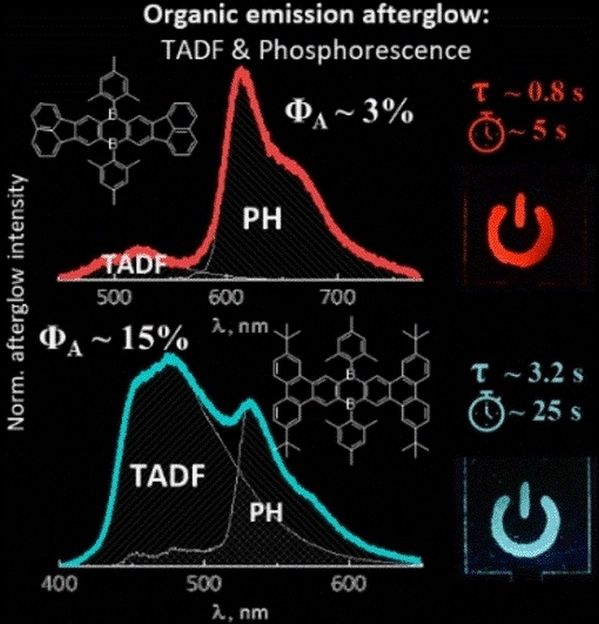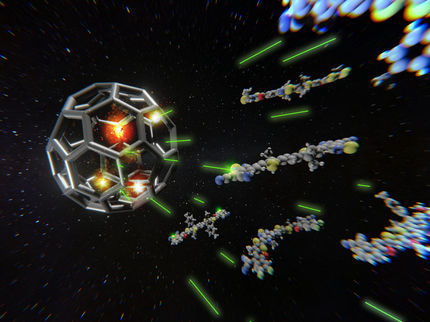Long-Lasting, Intense Afterglow
Organic dyes with persistent delayed fluorescence and ultralong phosphorescence
A team of researchers from Lithuania has developed organic dyes showing a particularly long afterglow after being excited by light. Doping a polymer with newly synthesized diboraanthracene dyes resulted in an intense red or blue–green dual afterglow, which was composed of persistent thermally activated delayed fluorescence and long phosphorescence at room temperature, the team reports in the journal Angewandte Chemie. Such organic materials can find important optoelectronic applications, such as in data encryption, information recording, and sensors.

© Wiley-VCH
“When you try to develop materials with a more efficient phosphorescence, the problem is that a more intensive phosphorescence often results in the decrease of phosphorescence lifetime and vice versa,” says Justina Jovaišaitė from Vilnius University (Lithuania), the corresponding author of the study. To overcome this problem, the team developed diboraanthracene dyes, for which the efficiency of long-lasting phosphorescence was supplemented by the efficiency of persistent thermally activated delayed fluorescence.
To achieve the desired dual afterglow, the team modified the diboraanthracene scaffold by synthetic methods. Diboraanthracene compounds have the basic aromatic structure of the organic chemical anthracene but contain two boron atoms. Synthetic modification not only lead to a more intense afterglow than in purely phosphorescing materials, but it also allowed the researchers to create organic dyes with different afterglow colors, which were tunable. “Upon cooling, the afterglow color either shifted from red to green or from green to blue. This can be of extreme importance for development of temperature sensors,” Jovaišaitė says.
The newly developed organic dyes could be used in data recording and information encryption. To demonstrate this, the researchers prepared transparent layers coated by the studied organic compounds. They irradiated the samples with intense laser light to write information, which could be read when the entire layer was exposed to less intense UV light.
The researchers hope that, through more in-depth investigation of the photophysical properties of their system, they will be able to optimize and control these afterglow properties further. They plan to increase duration, efficiency, and tunability of the afterglow. “Polymer-based organic afterglow materials are desirable because of their flexibility, transparency, and suitability for large-scale production,” Jovaišaitė says.
Original publication
Other news from the department science

Get the chemical industry in your inbox
By submitting this form you agree that LUMITOS AG will send you the newsletter(s) selected above by email. Your data will not be passed on to third parties. Your data will be stored and processed in accordance with our data protection regulations. LUMITOS may contact you by email for the purpose of advertising or market and opinion surveys. You can revoke your consent at any time without giving reasons to LUMITOS AG, Ernst-Augustin-Str. 2, 12489 Berlin, Germany or by e-mail at revoke@lumitos.com with effect for the future. In addition, each email contains a link to unsubscribe from the corresponding newsletter.




























































